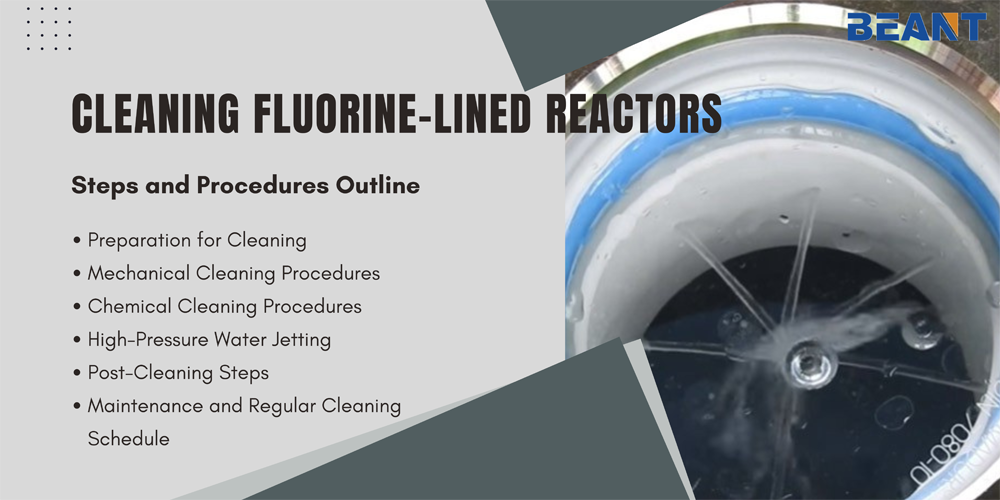
Fluorine-lined reactors are essential in various industries, particularly in chemical processing, due to their excellent resistance to corrosive substances. Maintaining these reactors' cleanliness is critical for ensuring optimal performance, longevity, and safety. Proper cleaning procedures help prevent contamination, improve efficiency, and extend the reactor's lifespan. This article provides a detailed guide on the steps and procedures for effectively cleaning fluorine-lined reactors, addressing common challenges and offering practical solutions.
Before beginning any cleaning process, safety is paramount. Ensure all personnel involved in the cleaning operation are equipped with appropriate PPE, including chemical-resistant gloves, safety goggles, face shields, and protective clothing. Adequate ventilation should be maintained in the cleaning area to prevent the accumulation of hazardous fumes. Additionally, all safety data sheets (SDS) for the cleaning agents being used should be reviewed, and emergency procedures should be in place.
Assemble all necessary tools and materials before starting the cleaning process. This includes non-abrasive brushes, scrapers, chemical cleaning agents, high-pressure water jetting equipment, buckets, hoses, and drying materials. Ensure all tools are clean and in good working condition to avoid introducing contaminants into the reactor.
Conduct a thorough initial inspection of the reactor to identify any visible residues, deposits, or damages. Document the current condition of the reactor with notes and photographs. This documentation will serve as a baseline for assessing the effectiveness of the cleaning process and for future reference.
Mechanical cleaning involves physically removing residues from the reactor's interior surfaces using tools and manual effort. This method is effective for removing solid deposits and built-up contaminants that may not respond well to chemical cleaning alone.
If possible, disassemble the reactor to allow access to all internal surfaces. This may involve removing baffles, agitators, and other removable parts. Carefully label and store each component to ensure proper reassembly.
Use non-abrasive scrapers and brushes to remove deposits from the reactor's walls and components. Stainless steel or plastic scrapers are suitable, as they do not damage the fluorine lining. Brushes with soft bristles can be used to scrub away stubborn residues. Avoid using metal brushes that could scratch or compromise the lining.
Non-abrasive tools such as plastic spatulas and nylon brushes are recommended for cleaning delicate surfaces. These tools effectively remove contaminants without causing damage to the fluorine lining. Apply gentle pressure to avoid scratching the surface.
Chemical cleaning involves using specialized cleaning agents to dissolve and remove contaminants. This method is particularly effective for removing chemical residues and biofilms that mechanical cleaning may not fully eliminate.
Choose cleaning agents that are compatible with fluorine-lined surfaces. Acidic or alkaline cleaners may be used, depending on the type of contaminants. Ensure the chosen chemicals do not react with the reactor's lining material. Consulting with the reactor manufacturer or a chemical cleaning expert can help identify the most suitable cleaning agents.
Prepare the cleaning solution according to the manufacturer's instructions. Apply the solution evenly to the reactor's interior surfaces using a sprayer or by filling the reactor. Allow the solution to sit for the recommended dwell time to effectively dissolve contaminants. Agitate the solution if necessary to enhance its cleaning action.
After the dwell time, thoroughly rinse the reactor with clean water to remove all traces of the cleaning agent and dissolved contaminants. Use a neutralizing agent if the cleaning solution was acidic or alkaline to ensure all residues are neutralized. Perform multiple rinses if needed to achieve a completely clean surface.
High-pressure water jetting is a highly effective method for cleaning fluorine-lined reactors, particularly for removing tough deposits and residues. This method uses high-pressure water streams to dislodge and wash away contaminants.
Set up the water jetting equipment according to the manufacturer's instructions. Ensure all connections are secure and that the equipment is in good working condition. Use nozzles designed for precision cleaning to avoid damaging the fluorine lining.
Direct the high-pressure water stream onto the contaminated surfaces, starting from the top and working downwards. Maintain a consistent distance between the nozzle and the surface to ensure even cleaning. Move the nozzle in a controlled manner to cover all areas without causing damage.
High-pressure water jetting poses significant safety risks. Operators should wear appropriate PPE, including face shields and protective suits. Ensure that the work area is clear of non-essential personnel and that proper barriers are in place to prevent accidental exposure to the high-pressure stream.
After completing the cleaning process, conduct a thorough inspection of the reactor's interior surfaces. Look for any remaining residues or areas that may require additional cleaning. Use a flashlight or inspection camera to check hard-to-reach areas.
Allow the reactor to dry completely before reassembling the components. Use clean, dry cloths to wipe down surfaces if necessary. Reassemble the reactor carefully, ensuring all components are correctly positioned and secured. Check for proper sealing and alignment.
Document the entire cleaning process, including the methods used, cleaning agents, dwell times, and any issues encountered. Take photographs of the cleaned reactor for future reference. This documentation will be valuable for maintaining a cleaning history and for troubleshooting any future cleaning challenges.
Develop a regular cleaning schedule based on the reactor's usage and the nature of the processed materials. Regular cleaning prevents the buildup of contaminants and ensures consistent reactor performance. Include routine inspections in the schedule to identify and address any early signs of contamination.
Monitor the reactor's performance after cleaning to ensure it operates efficiently. Track parameters such as temperature, pressure, and reaction rates to detect any deviations that may indicate residual contamination or other issues.
Implementing best practices for regular maintenance can significantly extend the reactor's lifespan. These practices include:
1.Regularly inspecting and replacing worn or damaged components.
2.Keeping detailed maintenance records.
3.Training personnel on proper cleaning and maintenance techniques.
4.Using high-quality cleaning agents and tools that are compatible with fluorine-lined surfaces.
Proper cleaning of fluorine-lined reactors is crucial for maintaining their efficiency, safety, and longevity. By following a structured cleaning process that includes mechanical, chemical, and high-pressure water jetting methods, operators can effectively remove contaminants and ensure the reactor's optimal performance. Regular maintenance and adherence to safety protocols further enhance the reactor's reliability and lifespan. Documenting the cleaning process and results provides valuable insights for future cleanings and helps in maintaining a high standard of reactor hygiene. Implementing these best practices will contribute to the overall success and productivity of operations involving fluorine-lined reactors.
Feel free to leave your message on our board. If you're looking to inquire about prices or place an order, this is the right place! Let us know the details of your needs, and our team will get back to you with a personalized quote as quickly as possible. We're here to ensure your experience is seamless and satisfactory. Share your requirements or ask any questions you might have - we're eager to assist and look forward to doing business with you!
Name:Tim
Phone:+86-15716151880
Email:[email protected]
Company:BEANT
Address:No. 28, Luoshen Road, Luoshe Town, Huishan District, Wuxi City, Jiangsu Province
